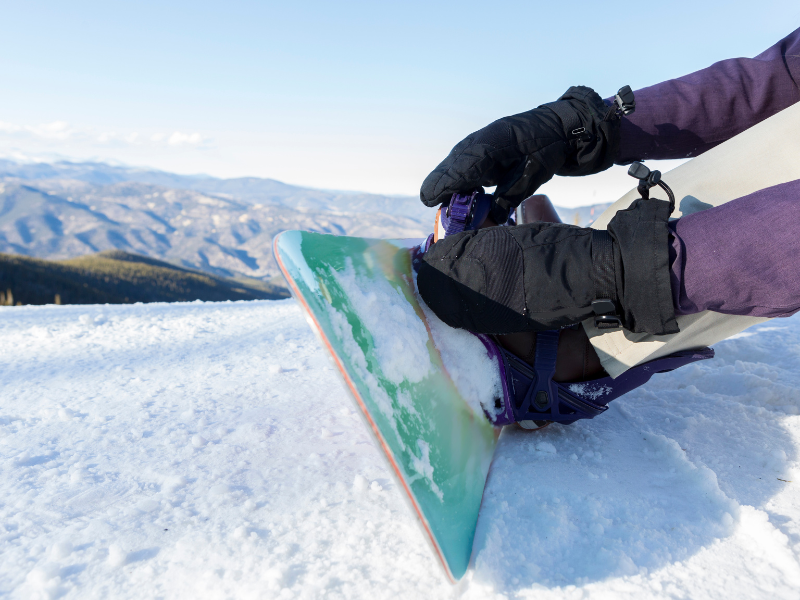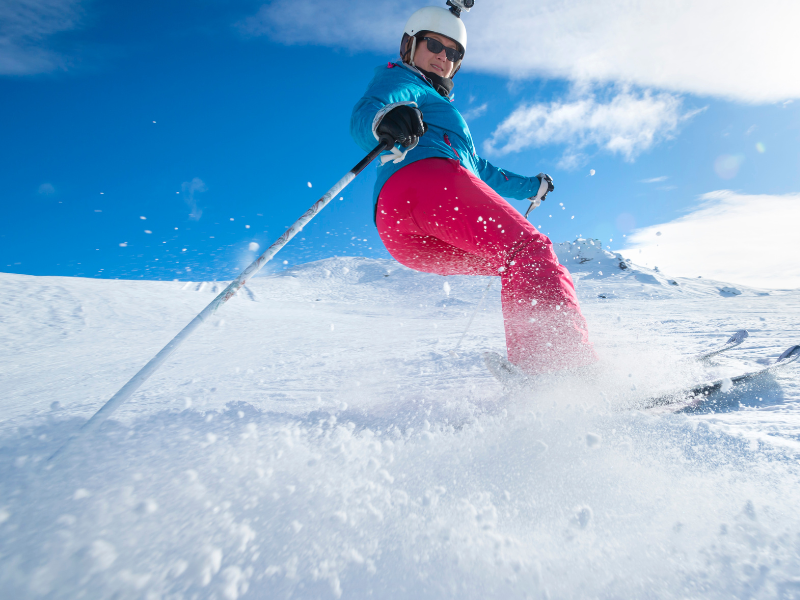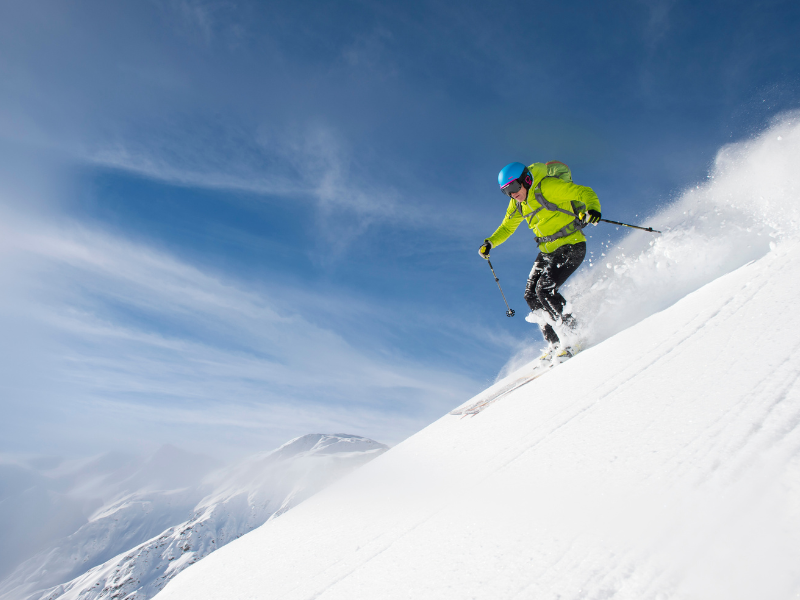The size of your foot can change the entire equation of renting or shopping for a new snowboard. The length of a snowboard is certainly important, but the width is of equal importance if you're looking to have a fun time on the mountain.
A snowboard's width is determined by the size of a person's boot and how it fits to a board's waist width - the larger the boot, the wider the board. There are four general widths of snowboards; narrow/women's, regular, mid-wide, and wide.
For the best fit, your boots should ever so slightly hang over the edges (heel and toe) but not to the point where you create heel-and-toe drag. So let’s explore some tips and tricks to determine what size board you'll need, to maximize your range of movement and good times.
What's Considered A Wide Snowboard?
A proper snowboard width will prevent heel and toe drag, so it's important to get this right. Conversely, riding a board that's too wide makes it difficult to get the board on its edge and turn corners.
This is a huge part of why it's so important to get the right width for your board.
So what exactly is the width, and how do you find the width of a board? For starters, the width of the board is commonly labeled the “waist” or "waist width" by manufacturers, typically measured in mm.
You'll come across categories of sizes like narrow/women's, regular, mid-wide, and wide, but the waist width is the definitive guide for measurement of a snowboard's width. Some manufacturers won’t use the term width, so keep your eyes open for "waist."
The width, or waist, is measured at the narrowest part which is usually in the middle of the board. However, don't assume your boot size compares directly to the waist - that is, don't think that if your boot size is larger than the waist, then you need to size up.
Your feet will not stand on the waist, which is the narrowest part of the board. Instead, your feet will stand in bindings on either side of the waist.
The following is a look at how three reputable organizations in snowboarding (two retailers, one publication) define each class of snowboard sizes, based on waist width.
There's a bit of discrepancy in how a wide board is defined - some start it at 260mm, while others gauge wide at 266mm - but in the table above, you'll find the wide range was set at 266mm+.
Wide is, more often than not, built for a men's size 11 boot or higher. Narrow boards can go all the way down to 225mm, and 225mm-235mm is normally suited for up to a women's size 6 boot.
There's so much variance in boot size by each brand, that it's challenging to answer the "exact" width that applies to boot size, but further into this article, you'll find a simple calculator you can use to gauge the range of snowboard width that might suit you best based on your boot size.
"How Wide Of A Snowboard Do I Really Need?"
That's a common question around here. Finding a wide model can sometimes be frustrating, but for our larger-footed friends, your board needs to be properly sized. When looking to buy your own board, you may be wondering what size you will need.
In the past, snowboarders with larger feet didn’t have as many options as today. Thankfully that's changed, leading to a wide range of snowboards for people of all sizes to pick from.
The sizes depend on a few things: where they were made, and male versus female sizes. As mentioned above, a board that is considered wide will be more than 260mm. This compares to about a size 12 (Or above) in men’s boots (see calculator above.)
There are also mid-wide boards which are about 255 to 260mm. This width board will be great for men who wear between a size 10 and 12 in boots. On the other hand, a normal (non-wide) board is what many people will need.
If your shoe size is about a women’s size 10, or between an 8 and 10 for men’s, you'll most likely fall in a regular width board. If you fall under this category, avoid using a wider board - it could be less safe and harder to control.
Finally, there are narrow boards for smaller feet. The majority of women’s boards fall within the narrow class. Most often, men who wear below an 8 and women below a size 10 should use this type of board.
In general, the standard boot sizes in the following boot size to snowboard width calculator will cover the majority of boots out there.
Simply type in your boot size, regardless of men's or women's, and you'll get the range waist widths that would most likely be the right fit for you.
Take the calculator above with a "Do your own research" approach; check the brand’s definition of wide just to be sure.
How Should My Boots And Board Align?
The width of the boots and the width of the board go hand in hand. They need to be lined up in a certain way to maximize balance. But again, snowboard boot sizes typically vary based on where they were manufactured, so don’t depend on having one size.
When a snowboard width is sized properly, your snow boots will hang over the edges slightly, about a half to three-quarters of an inch. They should hang off the board just enough, but not so much that they interfere with the snow.
Lining them up properly will help you in the long run. Getting the proper size allows you to apply leverage to the board and keep pressure on your ankles.
It's not just the size of the boots though, it's also placement. The angle on snowboard bindings determines the size boot that can fit on a particular snowboard. A tighter angle will make your boot sit higher and fit on a narrower board.
Prepping for Your Snowboard Purchase - 7 Tips
If you're new to this world of sizing, the easiest route is to go to a local shop and get assistance sizing your gear. Below, you'll find a short list of tips to keep in mind when you head out to purchase your board. Think of the following as your assistant to be an informed customer - let's have a look, in no particular order:
1. Heel Cup Adjustments
You can adjust your heel cup bindings to be back towards the heel edge or closer to the toe. Although this is a minor adjustment, its purpose is to make sure your feet are in the proper placement and centered over the footbed.
2. Binding Stance Angles
The angles of your bindings are primarily driven by your boot size, so this will be personalized for you. Angles should be offset by at least 18 degrees and a rule of thumb is any boot size larger than 13 should be 30 degrees or greater.
3. Men’s vs. Women’s Boards
While women can use men’s boards and vice versa, there are some reasons to potentially avoid this. Boards are built differently in terms of width and stiffness. Men’s boards are a bit wider and stiffer than women’s.
For women with larger feet, you may be limited in your options and have to opt for a men's board.
4. Don’t Buy Based On Length
There is much more to a snowboard than the length. Two boards with identical lengths could be built for two different riders. The length can be deceiving, which is why it’s important to consider width, stiffness, experience, and style as well.
5. No Boot is Created Equally
Similar to boards, every boot is different - this has been touched on ad nauseum above, but it's critical to mention again - a one-size guide won't work for every boot and board combination. Always check how much your boots hang over your snowboard.
6. Wide Doesn't Mean Better
The width of a board isn't an upgrade - it's simply a size classification. You should only get a wide snowboard if the size is right for you. If the board is too big, you can't react quickly enough. Ultimately, if you have larger feet, yes, wide will be your choice, and it will be better for you. But if that isn’t you, don't force your way into a wider board - it's not an upgrade.
7. Test the Board!
The best way to know if a board is a right fit for you is to give it a test run. Nobody will know the right fit better than you. If you’re thinking of buying a snowboard but don’t know what size is right, try it out! Putting your boots on and testing them with the board is truly the best way to tell what size will fit you best.
Waist Width: The Overlooked But Important Snowboard Size
Anyone that works in the snowboard industry will put width up there as an important measure for fitting a customer to a snowboard, yet this is sometimes overshadowed by other sizing elements for many customers.
The reality is that many factors go into choosing a snowboard - length, stiffness, binding stance, experience, and of course waist width. And there's no glory in having a narrow board vs. a wide board, or vice versa. It's not a statement about you.
Rather, snowboard width is about finding the right size so you feel comfortable, fit properly on the board, and ultimately have the best damn time at the park.
With so much wiggle room in sizing, the best path is to do your research (like reading this article,) then head into your local shop and work through your options. Or you can of course reach out to the crew at Kenver and find the best board and boots for you.



